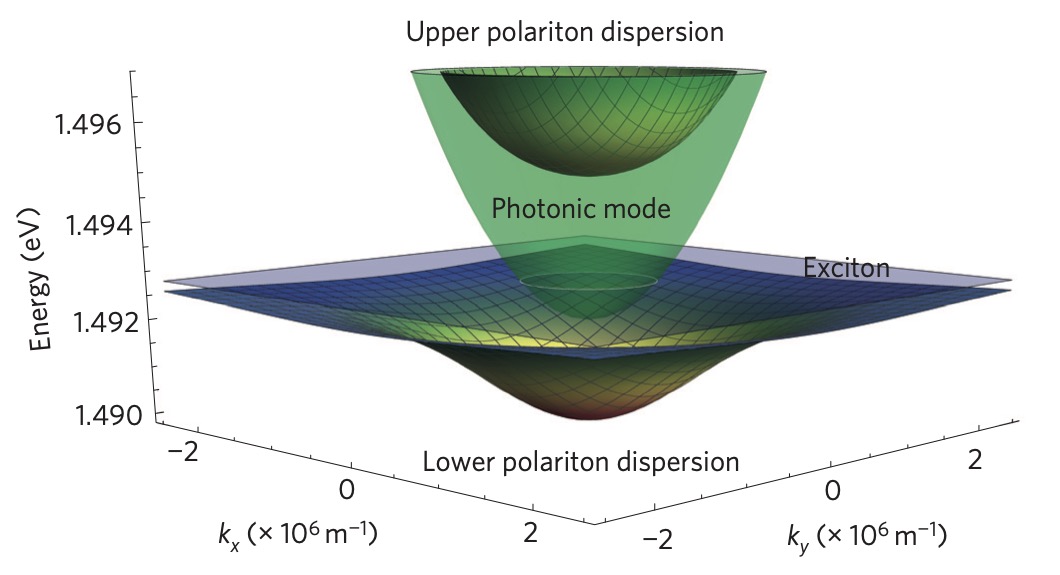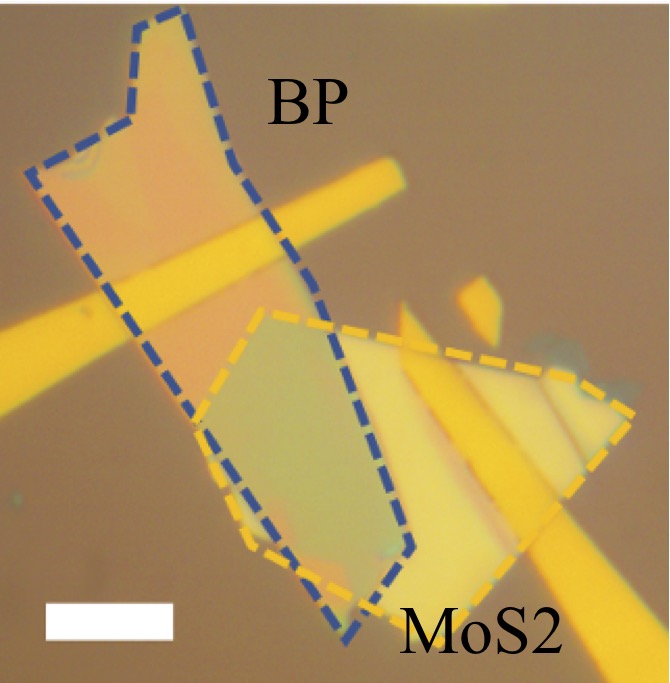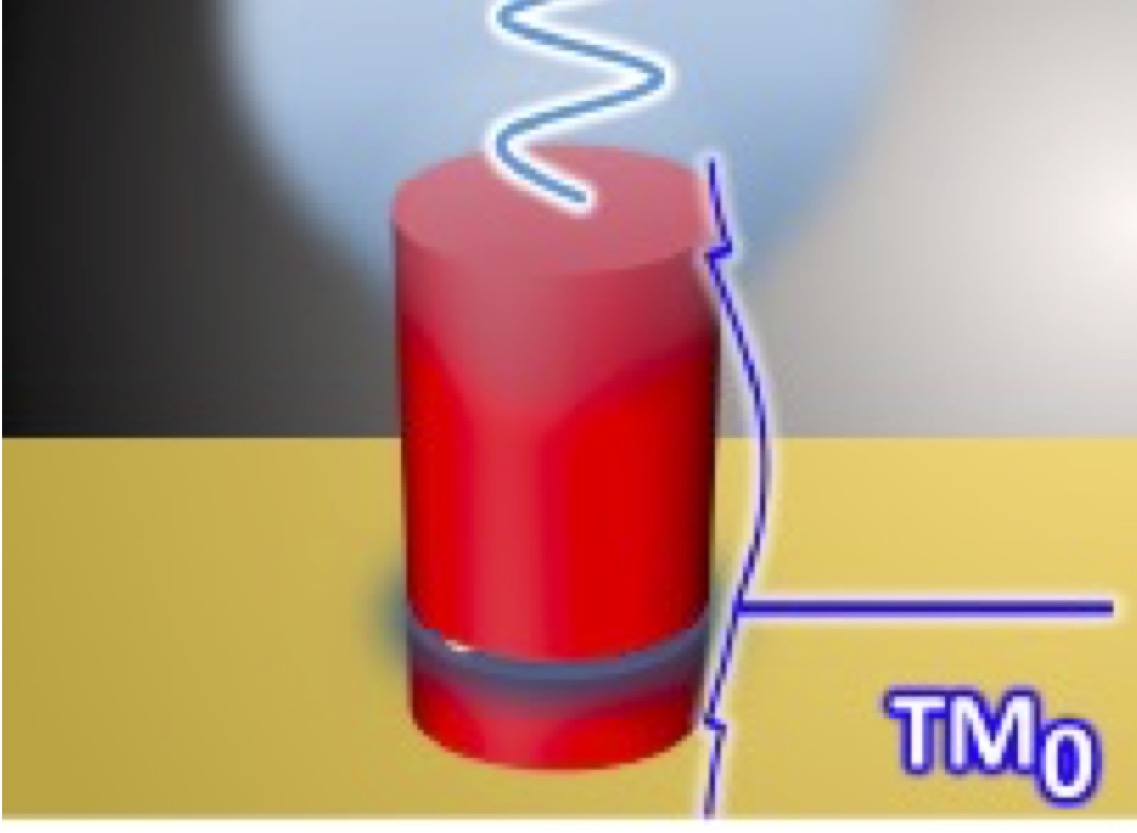Research
Our research lies at the interface between semiconductor physics, photonics and quantum optics. It is driven by a desire to understand the microscopic processes that take place in optical materials, with the aim of using them in state-of-the-art optoelectronic devices. Sometimes though we are just happy discovering funky new physics! In the group, we fabricate most of our own samples, build experimental setups to measure their properties and make complete devices that we can test. Our areas of interest are always evolving, but here are a few things that we are working on at the moment.
Strong light-matter coupling.  A longstanding interest in the group has been the regime of strong light-matter coupling. When an optical excitation (such as an exciton) interacts strongly enough with a mode of the electromagnetic field, new quasiparticles called polaritons can form. These polaritons are part-light, part-matter and share properties from both of their constituents. Because they are bosons, they can form Bose-Einstein condensates–even at room-temperature. Lattices of these condensates can be used for quantum simulation and single condensates can be used as low-threshold lasers. One current challenge when organic materials are used, is to lower the threshold sufficiently so that condensates can be realized with low-cost laser diodes. Another area we are exploring is to better understand how strong coupling can change the underlying properties of molecules themselves. Can phenomena such as conductivity, interesystem crossing, exciton dissociation be changed simply by changing the optical environment around the molecule? This could have important repercussion for many types of organic optoelectronic devices.
A longstanding interest in the group has been the regime of strong light-matter coupling. When an optical excitation (such as an exciton) interacts strongly enough with a mode of the electromagnetic field, new quasiparticles called polaritons can form. These polaritons are part-light, part-matter and share properties from both of their constituents. Because they are bosons, they can form Bose-Einstein condensates–even at room-temperature. Lattices of these condensates can be used for quantum simulation and single condensates can be used as low-threshold lasers. One current challenge when organic materials are used, is to lower the threshold sufficiently so that condensates can be realized with low-cost laser diodes. Another area we are exploring is to better understand how strong coupling can change the underlying properties of molecules themselves. Can phenomena such as conductivity, interesystem crossing, exciton dissociation be changed simply by changing the optical environment around the molecule? This could have important repercussion for many types of organic optoelectronic devices.
Organic light-emitting diodes and organic lasers.  Organic light-emitting diodes (OLEDs) are now routinely found in mobile displays and high end televisions, but the technology still faces several challenges for other applications. OLED efficiencies plummet in the ultraviolet and near-infrared. We recently demonstrated the feasibility of using thermally-assisted delayed fluorescence to achieve high quantum efficiencies at 840 nm. However, strategies for pushing this further are lacking. In addition, OLED efficiencies tend to drop drastically at high current densities, which prevents us from running devices at very high brightness. Most of the mechanisms responsible for this are known, but strategies for improving this efficiency drop are lacking. Similarly to OLEDs, organic lasers are easy to fabricate, cheap and easily tunable. However organic lasers tend to only work when pumped with intense short pulses of light. Major culprits are the presence of triplet excited-states and the thermal stability of materials. We are working on triplet management strategies to allow for continuous operation of organic lasers at low powers, and hopefully under electrical injection.
Organic light-emitting diodes (OLEDs) are now routinely found in mobile displays and high end televisions, but the technology still faces several challenges for other applications. OLED efficiencies plummet in the ultraviolet and near-infrared. We recently demonstrated the feasibility of using thermally-assisted delayed fluorescence to achieve high quantum efficiencies at 840 nm. However, strategies for pushing this further are lacking. In addition, OLED efficiencies tend to drop drastically at high current densities, which prevents us from running devices at very high brightness. Most of the mechanisms responsible for this are known, but strategies for improving this efficiency drop are lacking. Similarly to OLEDs, organic lasers are easy to fabricate, cheap and easily tunable. However organic lasers tend to only work when pumped with intense short pulses of light. Major culprits are the presence of triplet excited-states and the thermal stability of materials. We are working on triplet management strategies to allow for continuous operation of organic lasers at low powers, and hopefully under electrical injection.
Mid-infrared devices based on 2D black phosphorus  2D materials like graphene have shown amazing promise for electronics and optoelectronics. These are materials, which are layered in their bulk form, and the different layers can be re-arranged to form complex heterostructures tunable by both the choice of material and the twist-angle between layers. Black phosphorus, in particular, stands out as a truly amazing material. It has a direct bandgap from the monolayer to the bulk, which means that it is always an efficient emitter, and its emission wavelength can be dramatically tuned by applied electric fields, strain or the number of layers. We recently demonstrated the first MIR LEDs using black phosphorus, and we are working on improving the efficiency. These devices have the potential to dramatically outperform their conventional (and expensive!) epitaxially grown counterparts, and be integrated into complex photonic structures for trace gas sensing and other applications.
2D materials like graphene have shown amazing promise for electronics and optoelectronics. These are materials, which are layered in their bulk form, and the different layers can be re-arranged to form complex heterostructures tunable by both the choice of material and the twist-angle between layers. Black phosphorus, in particular, stands out as a truly amazing material. It has a direct bandgap from the monolayer to the bulk, which means that it is always an efficient emitter, and its emission wavelength can be dramatically tuned by applied electric fields, strain or the number of layers. We recently demonstrated the first MIR LEDs using black phosphorus, and we are working on improving the efficiency. These devices have the potential to dramatically outperform their conventional (and expensive!) epitaxially grown counterparts, and be integrated into complex photonic structures for trace gas sensing and other applications.
Optical antennas and optical nonlinearities  Like their radio frequency counterparts, optical antennas can re-shape the way light is emitted (say from an atom) or collected. We are designing new types of antennas to drastically enhance the emission of light-emitting diodes, individual quantum emitters and to increase the strength of nonlinearities by focussing light to nanoscale volumes. We are also developping new tools to precisely probe the strength of optical nonlinearities in the non-perturbative regime. Traditional measurement techniques such as Z-scan, fail when nonlinearities (or absorption) are very strong, which is precisely the case close to an optical resonance. Combining the two will allow us to realize efficient modulators, all-optical switches and frequency converters.
Like their radio frequency counterparts, optical antennas can re-shape the way light is emitted (say from an atom) or collected. We are designing new types of antennas to drastically enhance the emission of light-emitting diodes, individual quantum emitters and to increase the strength of nonlinearities by focussing light to nanoscale volumes. We are also developping new tools to precisely probe the strength of optical nonlinearities in the non-perturbative regime. Traditional measurement techniques such as Z-scan, fail when nonlinearities (or absorption) are very strong, which is precisely the case close to an optical resonance. Combining the two will allow us to realize efficient modulators, all-optical switches and frequency converters.
Photophysics of novel materials  We are always interested in better understand the behavior of optical excitations in newly discovered semiconductor materials. Our main tools for this are ultrafast spectroscopy and time-resolved microscopy. For example, we recently developped a single-shot technique to spatially and time-resolve carrier diffusion in the class of perovskites used in solar cells. With this technique, we were able to show that suprisingly, perovskite films with the longest carrier lifetimes showed some of the shortest in-plane diffusion lengths.
We are always interested in better understand the behavior of optical excitations in newly discovered semiconductor materials. Our main tools for this are ultrafast spectroscopy and time-resolved microscopy. For example, we recently developped a single-shot technique to spatially and time-resolve carrier diffusion in the class of perovskites used in solar cells. With this technique, we were able to show that suprisingly, perovskite films with the longest carrier lifetimes showed some of the shortest in-plane diffusion lengths.